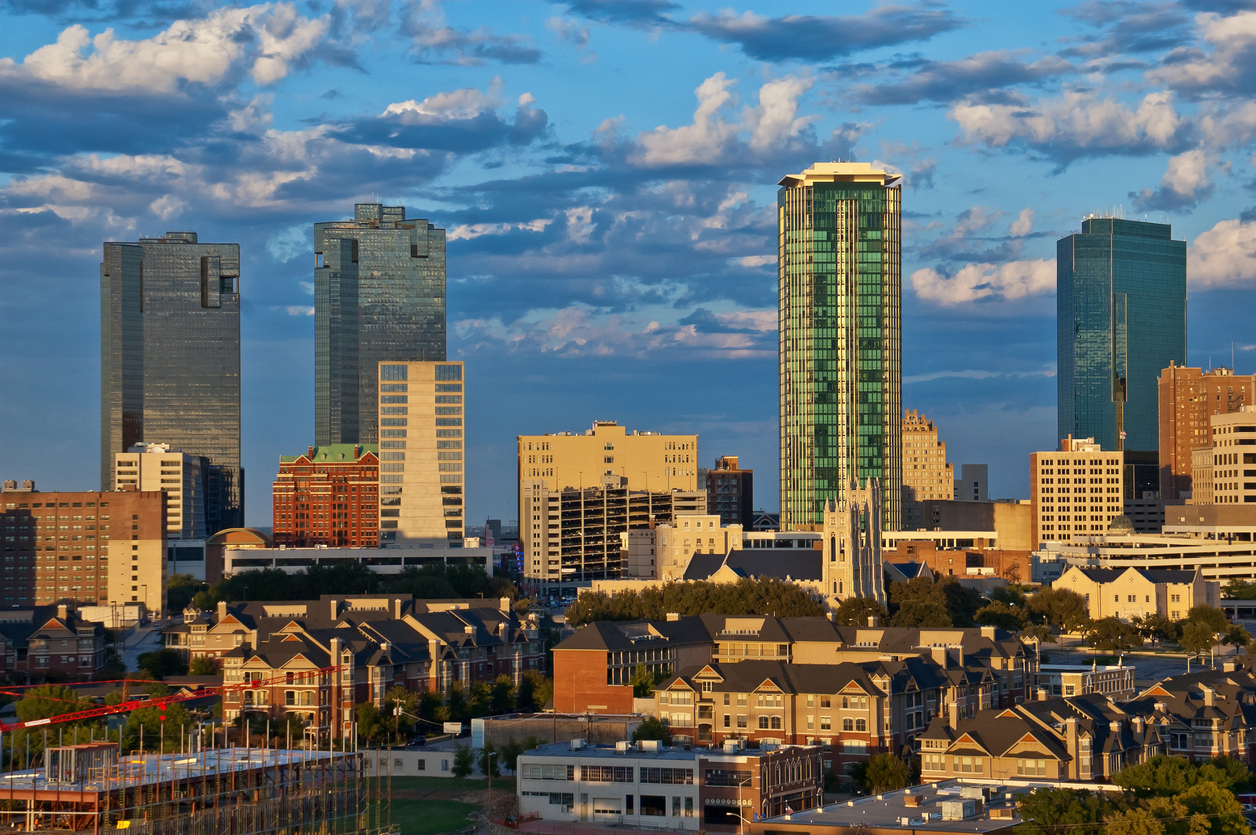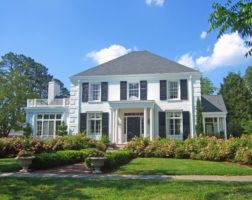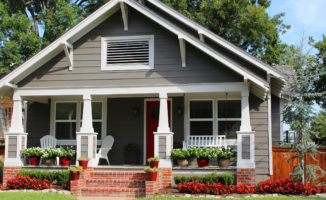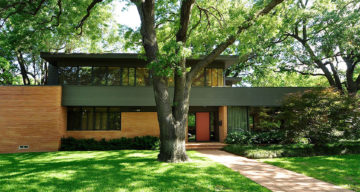Creating a Harmonious Whole
From an army fort established in the mid-19th century, Fort Worth has grown into the 13th-largest city in the country. Over the course of its 170-plus years, the city has embraced numerous architectural styles, all of which combine to add to Fort Worth’s charm.

Do you dream of living in an elegant Victorian two-story with a wrap-around front porch? Perhaps you’re looking for a family-friendly ranch home or a tasteful Craftsman bungalow. In Fort Worth, you’ll find new, historic, and renovated homes in myriad architectural styles. While many styles root themselves in bygone eras, you don’t necessarily need a historic house to get the look you want. New builds draw inspiration from classic motifs and offer distinct twists on contemporary and traditional design. From charming Tudors to streamlined mid-century moderns, discover the most coveted architectural styles in the city.
 Inspired by the Old World architecture brought to America with early settlers, Colonial architecture blends neoclassical stateliness with Puritan-style minimalism. It was the dominant design across the country in the 1700s – think Tara from Gone With the Wind. Although the style has many subsets (including Georgian, Dutch, and Cape Cod), the homes are usually symmetrical squares or rectangles with two or three stories. Dormer windows are a must. Living rooms and kitchens are located downstairs, and bedrooms are on the upper level. Side-gabled roofs and tall columns add grace and grandeur. Look for Colonial architecture in neighborhoods like Westover Hills, Ryan Place, and, of course, Colonial.
Inspired by the Old World architecture brought to America with early settlers, Colonial architecture blends neoclassical stateliness with Puritan-style minimalism. It was the dominant design across the country in the 1700s – think Tara from Gone With the Wind. Although the style has many subsets (including Georgian, Dutch, and Cape Cod), the homes are usually symmetrical squares or rectangles with two or three stories. Dormer windows are a must. Living rooms and kitchens are located downstairs, and bedrooms are on the upper level. Side-gabled roofs and tall columns add grace and grandeur. Look for Colonial architecture in neighborhoods like Westover Hills, Ryan Place, and, of course, Colonial.
While Colonial architecture is more subdued, intricate gables, ornate trim work, and wrap-around porches make Victorian architecture easy to recognize. Hailing from the reign of England’s Queen Victoria (1837-1901), these homes are usually two or three stories tall and feature complex, asymmetrical designs. Hexagonal and octagonal shapes are often found in Victorian architecture, along with bay windows, towers, and turrets. Look for elaborate gingerbread cutouts and spindles, along with turned posts and decorative railings. Victorian architecture is most often seen in Fairmount, Ryan Place, and Berkeley Place.
 Craftsman architecture’s clean lines and no-nonsense design came as a welcome reprieve after the embellishments of the Victorian era. Also known as Arts and Crafts, the aesthetic was spawned as a late 19th-century British and American movement to revive handmade artistry. Simple yet tasteful, casual, and well-constructed, the Craftsman style has far-reaching influence. Many homes feature wide eaves and low-pitched roofs with triangular framing. Front porches are ubiquitous and often adorned with thick, tapered columns. Built-ins and exposed beams give interior spaces a hand-hewn feel. Craftsman is the most popular architectural style in America and dominates Mistletoe Heights, Arlington Heights, and the Near Southside.
Craftsman architecture’s clean lines and no-nonsense design came as a welcome reprieve after the embellishments of the Victorian era. Also known as Arts and Crafts, the aesthetic was spawned as a late 19th-century British and American movement to revive handmade artistry. Simple yet tasteful, casual, and well-constructed, the Craftsman style has far-reaching influence. Many homes feature wide eaves and low-pitched roofs with triangular framing. Front porches are ubiquitous and often adorned with thick, tapered columns. Built-ins and exposed beams give interior spaces a hand-hewn feel. Craftsman is the most popular architectural style in America and dominates Mistletoe Heights, Arlington Heights, and the Near Southside.
Curved roof lines and decorative half-timbering are hallmarks of the Tudor style, an early 20th-century revival of late medieval architecture from the reign of Henry VIII. With intricate chimneys and steeply pitched gable roofs, Tudor architecture embraces a nostalgic lean towards English pastoralism and simpler times. From fairy-tale folk cottages to king-worthy mansions that evoke a countryside manor, these homes often boast embellished doorways, decorative chimney pots, and a quaint, storybook vibe. While they’re more common up north, Tudor homes make regular appearances in Rivercrest, Westover Hills, Arlington Heights, and the neighborhoods around TCU.
Laid-back and low-slung, ranch style homes embrace outdoor living and open floor plans (usually in a rectangle or L-shape). This uniquely American style rose to prominence in the 1950s and ‘60s, and the single-story design is still one of the most popular today. Ranch homes emphasize natural light, and the backyard is usually just steps away from the living room or kitchen. Their aesthetic of modern simplicity extends to the exterior, which is often covered with brick for easy maintenance. You’ll find these family-friendly homes throughout the city, but especially in Tanglewood, Overton Park, and Ridglea/Ridgmar.
 Referring to the years between 1933 to 1965, mid-century modern celebrates indoor/outdoor harmony with ample windows and natural light. Clean lines and organic elements dominate: warm woods, slate floors, travertine tiles, and voluminous stone fireplaces. Roofs are vaulted or flat. Sliding glass doors and clerestory windows let the outside in, while atriums create calm. Functional and futuristic at its inception, this style heralded a new era of progress and optimism in America that still rings true today. Most mid-century modern homes in Fort Worth are clustered in Ridglea Hills, Westcliff, and Morningside.
Referring to the years between 1933 to 1965, mid-century modern celebrates indoor/outdoor harmony with ample windows and natural light. Clean lines and organic elements dominate: warm woods, slate floors, travertine tiles, and voluminous stone fireplaces. Roofs are vaulted or flat. Sliding glass doors and clerestory windows let the outside in, while atriums create calm. Functional and futuristic at its inception, this style heralded a new era of progress and optimism in America that still rings true today. Most mid-century modern homes in Fort Worth are clustered in Ridglea Hills, Westcliff, and Morningside.
In other cities, these wildly diverse architectural styles could (and do) clash, but in Fort Worth, they harmoniously combine to create the city we know and love.
 Raised in the Fort Worth area, Shilo Urban moved to Austin, Maine, Paris, Seattle, New Zealand, and Los Angeles before finding her way home a few years ago. Along the way, she has had over three dozen different jobs, including high school French teacher, record label manager, and farmhand for endangered livestock breeds. She’s traveled to more than 50 countries and always has the next trip planned. Shilo has been a freelance writer for over a decade and has published in Fort Worth Magazine, Fort Worth Weekly, and Afar. Her interests include lost civilizations, jalapeño peppers, and Game of Thrones. She is currently writing a thriller and lives in Fort Worth with her weenie dogs, Steve and Lenny.
Raised in the Fort Worth area, Shilo Urban moved to Austin, Maine, Paris, Seattle, New Zealand, and Los Angeles before finding her way home a few years ago. Along the way, she has had over three dozen different jobs, including high school French teacher, record label manager, and farmhand for endangered livestock breeds. She’s traveled to more than 50 countries and always has the next trip planned. Shilo has been a freelance writer for over a decade and has published in Fort Worth Magazine, Fort Worth Weekly, and Afar. Her interests include lost civilizations, jalapeño peppers, and Game of Thrones. She is currently writing a thriller and lives in Fort Worth with her weenie dogs, Steve and Lenny.


 Sign in
Sign in

